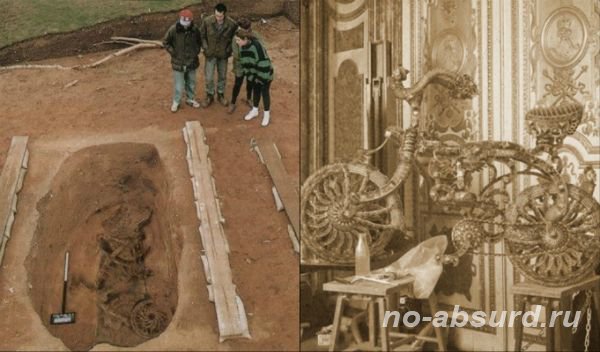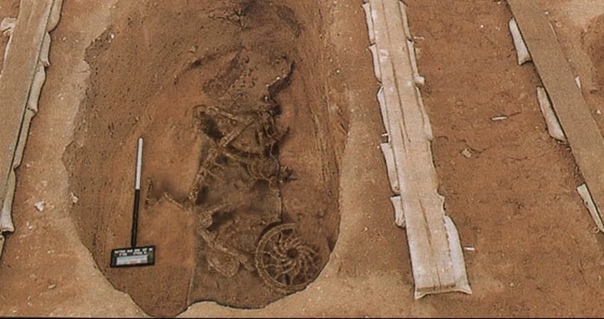Mind-Blowing Discovery! A Bike Buried in a Medieval Tomb – How Is This Possible?
A Bike Found in a Medieval Tomb Tells Us We Need to Question Our History
The discovery of a bicycle in a medieval tomb has left historians and archaeologists baffled, forcing us to reconsider the timelines of technological development and question long-held assumptions about history. This incredible find—something seemingly out of place by several centuries—raises a provocative question: what if our understanding of human innovation and the flow of time is incomplete, or worse, fundamentally flawed?

The Discovery That Defies Logic
In early 2024, a team of archaeologists excavating a long-forgotten medieval burial site in Eastern Europe stumbled upon a find that shook the academic community to its core: a remarkably well-preserved bicycle, buried alongside a nobleman thought to have died in the 13th century. The site itself had been unremarkable until this strange object was unearthed, igniting a storm of speculation and disbelief.
The bike, though rusted with time, resembled a design that would not have appeared until the late 19th century, almost 600 years later. Its frame, wheels, and chain drive mechanism were typical of bicycles from the Industrial Revolution era—yet here it was, lying within a tomb that predates modern technological advancements by centuries.
Could It Be a Hoax?
Many skeptics were quick to label the discovery a hoax, suggesting that the bike was somehow placed in the tomb much later. However, extensive testing on the surrounding sediment and the items buried alongside the bicycle has confirmed the tomb’s medieval origin. Carbon dating of the organic material surrounding the bike places the burial date somewhere in the mid-1200s, a period when humanity was far from developing complex machinery like bicycles.
Further investigations revealed that the metal used in the bike’s construction also aligned with medieval metallurgy, adding yet another layer of complexity to the mystery. If this bike wasn’t a product of some elaborate modern prank, it suggests something far more mind-boggling: either the technological capabilities of medieval societies were far more advanced than previously understood, or there are missing pieces in the timeline of human invention.
Rewriting the Technological Timeline
The discovery of this bike suggests that the development of human technology might not have been as linear as we once thought. Historians have traditionally viewed technological progress as a slow, steady march forward, with each era building upon the innovations of the previous one. According to this view, the Industrial Revolution, which began in the late 18th century, was the true dawn of modern machinery. However, the bike found in the tomb forces us to confront the possibility that advanced mechanical knowledge may have existed long before, only to have been lost to history.
Theories have emerged that challenge the conventional timeline. Some researchers speculate that isolated pockets of medieval societies might have had access to technologies that weren’t widespread and were forgotten with time, particularly during events like the Black Death or the many wars that ravaged Europe during the Middle Ages. Others suggest that secret guilds or inventors may have developed advanced machines but lacked the means to mass-produce or preserve them.

Could this be evidence of a lost technological tradition, where ideas flourished in small circles before being wiped out by plagues, wars, or other catastrophic events? The absence of written records or other similar artifacts might indicate that medieval inventors were far more resourceful than we’ve credited them for, but their creations simply didn’t survive the test of time—or were actively suppressed by powers that wanted to control the flow of knowledge.
The Time Traveler Theory
For the more speculative-minded, the discovery has sparked wild theories involving time travel or interdimensional phenomena. While these ideas sit firmly in the realm of science fiction, they reflect the profound discomfort that arises when our historical certainties are challenged. Could the bicycle have been transported through time, or are we looking at evidence of an alternate timeline intersecting with our own?
While far-fetched, these theories capture the imagination precisely because they highlight how little we know about the deeper workings of time, space, and history itself. Although it’s far more likely that this discovery points to an anomaly in our understanding of technological development, the bicycle’s presence in a medieval tomb leaves room for mystery and speculation.

The Larger Implications for History
The implications of this discovery extend beyond the realm of technological history. If the accepted timeline for the development of the bicycle is incorrect, how many other inventions might have origins far earlier than we currently believe? How many other elements of our historical understanding could be inaccurate? From the pyramids of Egypt to the lost knowledge of ancient civilizations, we may have to revisit and reinterpret countless aspects of human history.
More broadly, the bike found in the medieval tomb reminds us of the fragility of historical records. Much of what we know about the past is based on fragmented documentation, artifacts, and archaeological evidence. The discovery of one object can upend years of scholarship, forcing us to reevaluate everything we thought we knew.
Conclusion: A Call for Open Minds
The bicycle found in the medieval tomb is a powerful reminder that history is not a static, fixed narrative. It is a dynamic and evolving field of study, where new discoveries constantly challenge old assumptions. Whether this find turns out to be an isolated anomaly or part of a larger, hidden story of human innovation, it underscores the need to approach history with curiosity and an open mind.
In an age where we pride ourselves on our vast knowledge of the past, this discovery teaches us that there is still so much we don’t know. The bike found in the tomb might not just be a fascinating oddity; it could be the key to unlocking a hidden chapter of human history, one that demands we rethink the very foundations of our understanding of the medieval world and beyond.
Related Post
A shocking documentary proves that mermaids do exist
SHOCKING Revelation: Thuya, Mother of Queen Tiye, Was the Grandmother of Akhenaten and Tutankhamun—What Ancient Egyptian Secrets Did She Leave Behind?
Breaking News: Astonishing Discoveries at Karahan Tepe Confirm an Extraterrestrial Civilization is Hiding on Earth, and NO ONE Knows!
Breaking News: Researchers FINALLY Discover U.S. Navy Flight 19 After 75 Years Lost in the Bermuda Triangle!
NASA’s Secret Investigation: Uncovering the Astonishing Mystery of the UFO Crash on the Mountain!
Explosive UFO Docs LEAKED: Startling Proof That Aliens Ruled Ancient Egypt!